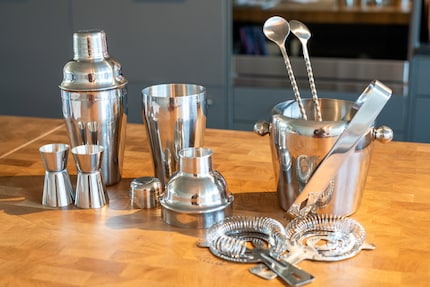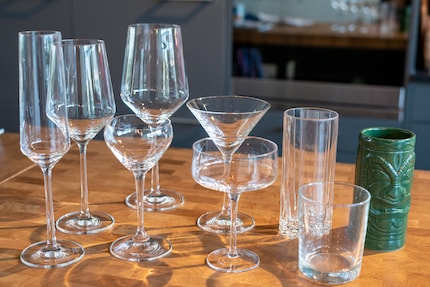

What all belongs in a house bar - utensils and glasses
I have set up a home bar for myself. What it really needs for it and what you can do without, I've summarized once. Part 1 of 2 is about utensils and glasses.
Whether in my home town of Chur, in small Zurich or in big Berlin - a good bar is a good bar. Countless glasses of various shapes and sizes are stacked on, at or against the wall behind the bar. Shakers, measuring cups, spoons and drinking straws are neatly lined up and waiting for the bartenders' nimble hands. Countless schnapps and liqueurs line up and are shaken and stirred with themselves, chilled lemonades or fruit juices to make sweet, fruity, sour or bitter cocktails.
Of course, only a fraction of the bar utensils are needed in your and my home bar. But which one? The offer is gigantic and the space in the private kitchen is limited. So here's a summary of what's available in terms of equipment. Most importantly, what you should buy for your home bar - and what I put in my bar.

Usually there are three types of cocktails: shaken, stirred and built - or in English: shake, stir, build. You could also mention blend (with an electric mixer), but we'll leave the few frozen drinks out of it.
The ingredients are shaken with ice in a shaker and shaken vigorously to mix everything well. The cocktail is poured through a sieve into a serving glass.
Stired, the ingredients come into a mixing glass with ice and are stirred thoroughly with a spoon and then poured through a strainer into the serving glass.
In a build, the drink is served directly in the serving glass and is served unmixed.
Shaker
Well, a shaker is a must in every house bar, no matter how small it is. But which one is the best to use? After all, there are different categories. Usually there are three different categories:
Tin in Tin Shaker
The Tin in Tin Shaker is probably the one you see most often in your local bar. Two metal cups with different volumes and diameters that are put together to shake drinks.

Boston Shaker
The Boston Shaker works on the same principle as the Tin in Tin Shaker, instead of the smaller metal cup, a glass is used. While this certainly looks good, it is more difficult to use because the glass is much heavier than the metal. And if I beginners shake the whole thing out of my fingers, it's pretty much bound to break.
Whether now the Boston Shaker is a variant of the Tin in Tin Shaker or vice versa, I can not say. I've read both.
Manhattan or Cobbler Shaker
The Manhattan/Cobbler Shaker consists of three parts: a cup, an attachment with a built-in strainer, and a small lid. It is the smallest, handiest shaker and closes the tightest.
I chose the Cobbler Shaker because I wanted to be on the safe side. Bars usually use the tin in tin shaker. Several bartenders I've read from consider the Cobbler to be the best starter shaker. Oh yeah, I have two of these ...
Stirring Glass
In a bar, of course, there's that extra. But honestly, I just stir drinks in the shaker. The volume is enough to have enough ice in it and to be able to stir the liquids well and thoroughly. What I need extra for that is a julep strainer, which is a strainer made especially for pouring cocktails.
Tools
Besides the vessel in which I mix my drinks, a bar needs some bigger and smaller tools. Some of them you already have in the kitchen, others you should get specifically.
It's not likely that you'll have a jigger in your kitchen. However, you tend to need two or three of them in your home bar. These measuring cups usually have two hollow measures, although these can differ depending on where they come from. In the USA they measure in ounces, in Europe in centiliters. Common measures are one with 2 cl and one with 4 cl. If you have a cobbler shaker, you could also use the lid as a measuring cup. This usually holds about 3 cl. More handy are commercial jiggers.
Here, too, it is worth making a specific purchase. Stirring spoons, with their long, twisted handles and their weight, fit well in the hand and can be used one-handed with a little practice. They are certainly long enough to stir in the mixing glass - or shaker - without problems and can also serve as a hollow measure. Usually a spoon holds 0.5 cl. Dessert spoons with long sticks could serve as a temporary substitute at best, but are less handy.
As soon as a drink contains fresh lemon, lime or orange juice or you need fresh fruit as decoration, you can't do without a sharp knife. A serrated utility knife will do just fine.
The strainer, actually Hawthorne Strainer, is an extra strainer that fits onto shakers to strain cocktails cleanly into the serving glass. Even if you have a cobbler shaker that already has the strainer built in, you still need a strainer in your home bar. At the very latest, you'll need it when you strain a stirred drink. Your mini kitchen strainer can't do the job because it's not big enough for the ice cubes. But there are drinks where you may need the kitchen strainer in addition to the strainer to safely catch everything that comes out of the shaker. Should you be working with a mixing glass, the so-called julep strainer is common.
A corkscrew and a bottle opener. They belong in every kitchen anyway.
Here we are with the non-essential utensils. While in a bar, depending on the drink, some little extras are grabbed with these tweezers-like tongs and needed for the preparation of your drink - ice cubes, straw, decoration - you can do without them at home. As long as you wash your hands regularly, as you should in the kitchen anyway.
Admittedly, it seems to be practical, the hand press to juice lemon and lime halves directly into the shaker. But it also works by hand or with the standard citrus juicer you pretty much have lying around in a kitchen drawer.
And again. For some drinks - the mojito, for example - the recipe says you need to mash ingredients in the glass. If you have a pestle anyway, use that. There are also mixing spoons that end in a sort of pestle at the end of the handle, which is intended for just such situations. Otherwise, you can buy special bar pestles, but you probably won't use them too often.
A separate ice container is definitely a nice-to-have at best. You'll only need it when you've got your home bar up and running and start hosting private cocktail parties.
Often forgotten, but very important: Ice
One thing you should definitely look for in your home bar - even if it can be tricky - is good ice. And that's where it gets tricky, because you usually can't make ice in large quantities at home. You tend to need three types of ice: classic, rather small ice cubes for shaking, crushed ice and large ice cubes for serving, depending on the drink. In the shaker, smaller cubes are better because they melt faster and a little melting water is needed to mix all the ingredients homogeneously and cool the whole thing down quickly. But the ice should not be too cold, so that it melts quickly enough. Because you don't run a professional bar at home, you can get by with what you have. Only the quantity has to be right. For your homemade crushed ice, the pro recommends freezing a block of ice in a Tupperware box and then crushing it with a rolling pin or meat mallet, wrapped in a kitchen towel. Or you can do it with the ice cubes you already have there.
So, of all the things I've now labeled as more or less necessary, I have standing around my house:
- 2 cobbler shakers
- 4 jiggers
- 2 stirring spoons
- 2 Strainer
- 1 ice bucket
I bought all of this specifically. What I already had in the kitchen are masses of peelers and peelers and a pestle.
So far I haven't bought - and don't miss - a hand press (the existing citrus press does so far) and a pair of tongs. I bought ice in large quantities at the gas station - crushed ice and ice cubes, each a 5kg bag. I've been using it for almost four months now. Before New Year's Eve I will hardly have to get new ice. My built-in freezer is now two-thirds full.
Glasses
I could shake or stir my drinks now. What's missing are the right glasses to serve and enjoy the cocktails. There are roughly three different types of glasses:

Highball-/Longdrink glasses, also Collins glass.
In principle, this is no different than a tall, relatively slim drinking glass that you have around in your cupboard as a water glass anyway. But it makes a bit more of a statement when you serve that Americano, mojito or tequila sunrise in a stylish highball glass.
You'll immediately recognize the classic martini glass by its triangular goblet shape. However, cocktail glasses come in a wide variety of shapes, even if they always resemble each other with the more or less long stem and a volume of plus/minus 2.5 deciliters. The glass itself can have different shapes from almost round to cylindrical to quite flat. You can even go back to your red and white wine glasses or flutes. The only rule you should stick to: The eye drinks with you. Although there are certain drinks in a bar that are always served in the same type of glass. This also applies to the next category.
The tumbler is actually nothing more than a low highball glass. Sour cocktails like the Daiquiri are usually served in tumblers - or simply a whiskey on the rocks.
It certainly makes sense to have a glass or two of each of these three categories on hand. How many exactly depends on how many guests you plan to serve cocktails to at the same time.
In addition, you will also find some more special cocktail glasses, which are summarized under the term Fancy. These include tiki mugs or copper mugs, but also any other unconventional vessel in which you serve a drink.
In my glassware cabinet are:
- 4 identical highball glasses
- 10 cocktail glasses in different shapes
- 6 identical tumblers
- 4 tiki mugs
Today I would say: I overshot the mark a bit. But because in our cocktail euphoria at the end of August we threw a family cocktail party for eight adults and two children (for them, of course, there were two, three different non-alcoholic drinks), we needed a few extra glasses. Since then, in regular use: three highballs and two cocktail glasses. And every now and then a tumbler. Three times four glasses is quite enough to start your home bar.
Why I bought a house bar in the first place, you can read here:
Globetrotter, hiker, wok world champion (not in the ice channel), word acrobat and photo enthusiast.
Practical solutions for everyday problems with technology, household hacks and much more.
Show all






